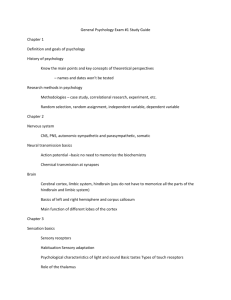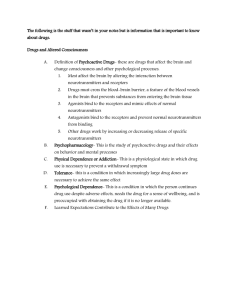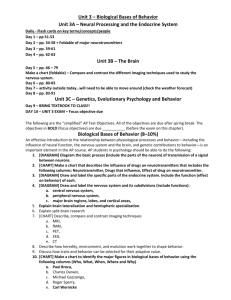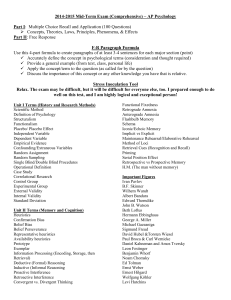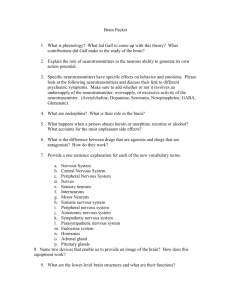Unit 3 – Neurobiology and Communication
advertisement
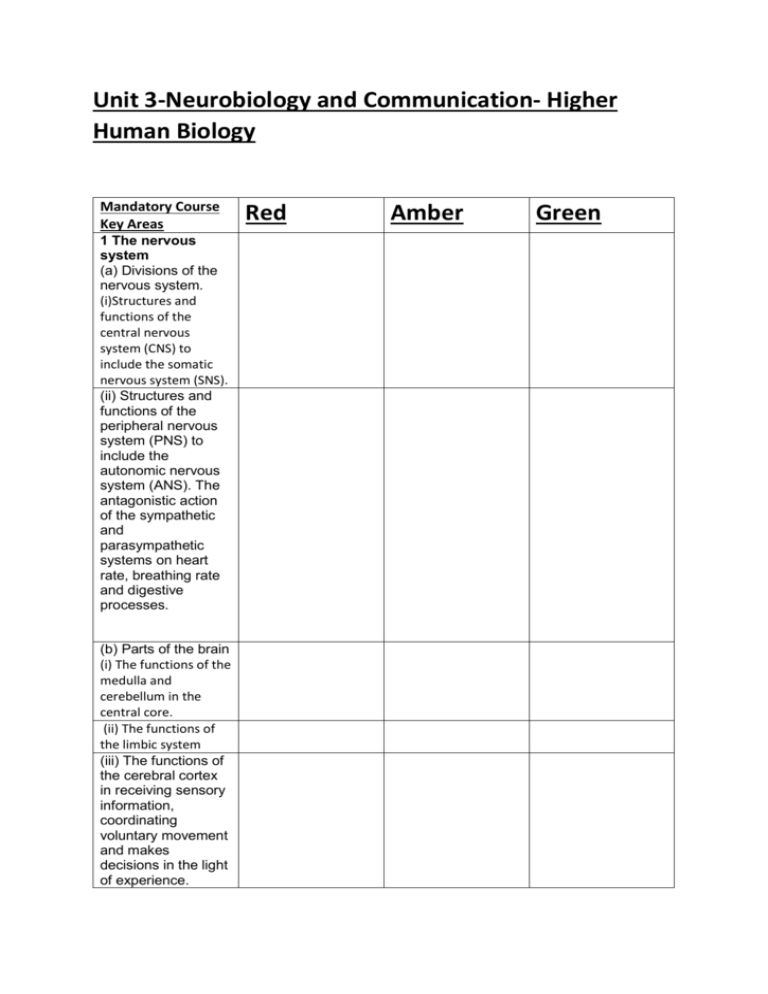
Unit 3-Neurobiology and Communication- Higher Human Biology Mandatory Course Key Areas 1 The nervous system (a) Divisions of the nervous system. (i)Structures and functions of the central nervous system (CNS) to include the somatic nervous system (SNS). (ii) Structures and functions of the peripheral nervous system (PNS) to include the autonomic nervous system (ANS). The antagonistic action of the sympathetic and parasympathetic systems on heart rate, breathing rate and digestive processes. (b) Parts of the brain (i) The functions of the medulla and cerebellum in the central core. (ii) The functions of the limbic system (iii) The functions of the cerebral cortex in receiving sensory information, coordinating voluntary movement and makes decisions in the light of experience. Red Amber Green (iv) Localisation of functions to include sensory areas, motor areas and the association areas concerning language, personality, imagination and intelligence. Information from one side of the body is processed in the opposite side of the cerebrum, transfer of information occurs through the corpus callosum. (c) Perception. Process by which the brain analyses and makes sense out of incoming sensory information. The three areas of perception are: (i) Segregation of objects. Perceptual organisation into figure and ground. Perceptual organisation of stimuli into coherent patterns. Visual cues such as relative size, superimposition and relative height in field. Binocular disparity in judging distance. Perceptual constancy as objects become nearer and the viewing angle changes. The importance of shape rather than detail in the recognition of objects. Matching perceived shapes to shape descriptions stored in memory and the role of inference in recognition. The influence of perceptual set where past experience, context or expectation influences the way a stimulus is perceived. (ii) Perception of distance. (iii) Recognition. (d) Memory as storage, retention and retrieval of information. All information entering the brain passes through sensory memory and enters shortterm memory. Information is then transferred to longterm memory (LTM) or discarded. (i) Sensory memory — lasts a few seconds and retains all of the visual or auditory input. (ii) Short-term memory (STM). To include memory span, the serial position effect, maintaining items by rehearsal and loss of items by displacement and decay. Improvement of STM by ‘chunking’. (iii) Long-term memory (LTM). The transfer of information from STM to LTM due to rehearsal, organisation and elaboration. Information is encoded using shallow encoding or elaborative encoding. Retrieval is aided by the use of contextual cues. (iv) Location of memory in the brain. Episodic and semantic memory are stored in the cortex. Procedural memories (skills) are linked to the motor cortex. Emotional memories involve links between the cortex and the limbic system. Spatial memory is located in the limbic system. (e) The cells of the nervous system. (i) Structure and function of neurons to include dendrites, cell body and axons. Sensory, motor and inter neurons. Structure and function of myelin sheath in increasing the speed of impulse conduction. Myelination continues from birth to adolescence. (ii) Glial cells. Physically support neurons and produce the myelin sheath (f) Neurotransmitters at synapses. Chemical transmission at the synapse by neurotransmitters to include vesicles, synaptic cleft and receptors. The need for removal of neurotransmitters by enzymes or reuptake. Receptors determine whether the signal is excitatory or inhibitory. Synapses can filter out weak stimuli arising from insufficient secretion of neurotransmitters. Summation of a series of weak stimuli can trigger enough neurotransmitter to fire an impulse. (i) Function of converging, diverging and reverberating neural pathways. Plasticity of response is created when new neural pathways are developed to create new responses, bypass areas of brain damage, to suppress reflexes or responses to sensory impulses. (ii) Neurotransmitters, mood and behaviour. The functions of endorphins and dopamine. Endorphins are neurotransmitters that stimulate neurones involved in reducing the intensity of pain. Increased levels are also connected with euphoric feelings, appetite modulation and release of sex hormones. Endorphin production increases in response to severe injury, prolonged and continuous exercise, stress and certain foods. Dopamine induces the feeling of pleasure and reinforces particular behaviour in the reward pathway. Neurotransmitter related disorders and their treatment. Agonists bind to and stimulate receptors mimicking the neurotransmitter. Antagonists bind to specific receptors blocking the action of the neurotransmitter. Other drugs inhibit the enzymes which degrade neurotransmitters or inhibit re-uptake. (iii) Mode of action of recreational drugs. Can mimic neurotransmitters. Changes in neurochemistry alter mood, cognition, perception and behaviour. Many recreational drugs affect neurotransmission in the reward circuit of the brain. Drug addiction/tolerance. Sensitisation is an increase in the number and sensitivity of neurotransmitter receptors as a result of exposure to drugs that are antagonists and leads to addiction. Desensitisation is a decrease in the number and sensitivity of receptors as a result of exposure to drugs that are agonists and leads to drug tolerance. 2 Communication and social behaviour (a) The effect of infant attachment. (i) Infant attachment studies. Early infant attachment is important in laying the foundation for the future formation of stable relationships. (ii)Socialisation and learning. Humans have a long period of dependency on adults providing time for socialisation and learning to occur. Authoritative control generally results in greater social competence than permissive control. (b) The effect of communication. (i) The importance of non-verbal communication in the formation of relationships between individuals and can signal attitudes and emotions as well as acting as an aid to verbal communication.. (ii) Verbal communication is used in the transmission of knowledge, development of culture and social evolution. (c) The effect of experience. Learning is a change in behaviour as a result of experience. (i) The repeated use of a motor skill results in a motor pathway being established. (ii) Imitation. Human behaviour may be learned by observation and imitation. (iii) Reinforcement, shaping and extinction of behaviour as seen in trial and error learning. (iv) Generalisation and discrimination. (d) The effect of group behaviour and social influence. (i) Social facilitation. Increased performance in competitive situations. (ii) De-individuation. Loss of personal identity in a group leading to diminished restraints on behaviour. (iii) Internalisation is the changing of beliefs as a result of persuasion. Identification is the changing of beliefs to be like an admired influencing source.


